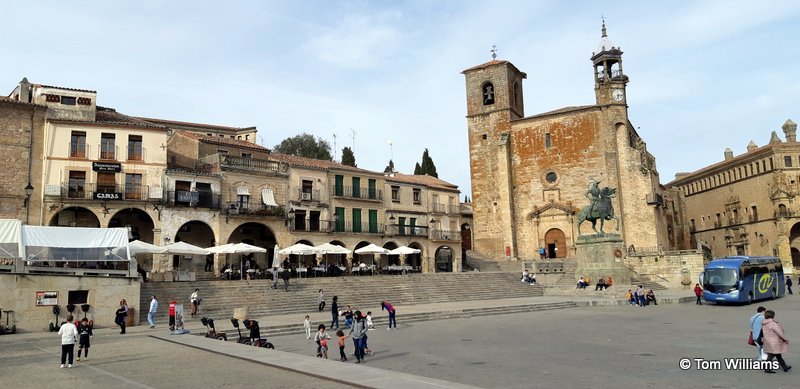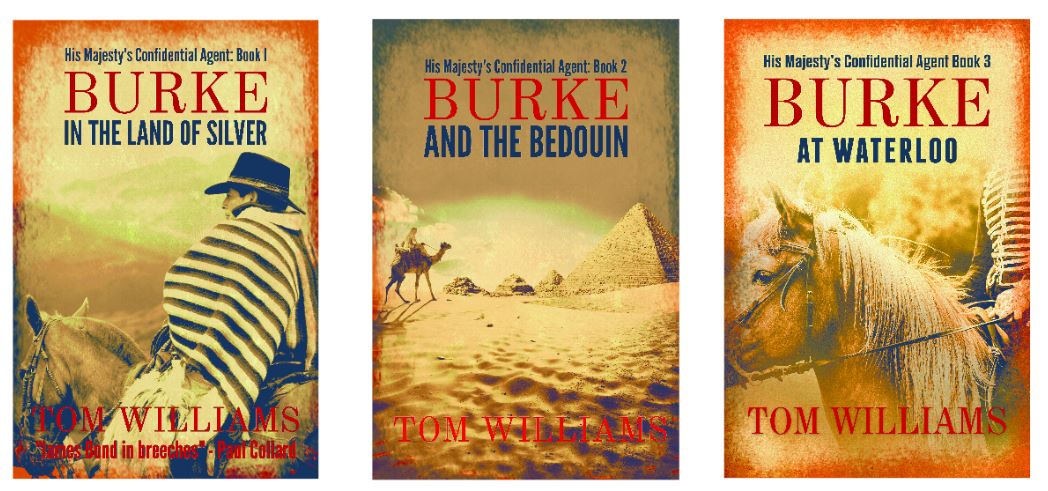I’m writing a book set in the Peninsular War and featuring the battle of Talavera, but I have never been to Spain. (Barcelona doesn’t count.) Last week I put that right with a whistle-stop tour of some key Napoleonic War sites in Spain and Portugal. We took a look at quite a lot of medieval stuff too, just because it was fabulous.
Day 1: Toledo
Arrived Madrid to discover that the hire car we booked had been upgraded to something bigger. This was (as you will soon discover) not necessarily a good thing.
Drove to Toledo. It’s not that far and it turns out that Spanish motorways are uncrowded and easy to drive on. It’s only when we turned off for Toledo that things began to get sticky.
Our hotel was on the very edge of the old centre of town, just after a very sharp turn-off. We missed it and by the time we realised our mistake a few seconds later, we were unable to turn back. Instead we had to drive right through Toledo and swing round for a second attempt.
The good news is that old Toledo is very beautiful. It’s a medieval town and the basic buildings seem unchanged. In England we often talk about towns having “their ancient street plan” but I doubt many Saxons would relate to the Saxon street plan of Richmond (where I live) for example. Over the centuries building lines have been pushed back and roads widened to accommodate motor vehicles. By contrast, the roads in Toledo have been left pretty much as they were around 1500. One of them is shown in the photo below – and, yes, this is a regular road as used by cars.

Our car was considerably less shiny and scratch-free by the time we had circled round for our second attempt at the hotel, though I had managed to avoid hitting any of the people who (quite rightly) see the streets as being for pedestrians first and cars second.
Our second venture into the town was on foot and we wandered aimlessly about enjoying the sense of having moved back through 600 years – or rather more when we stumbled across the remains of the Roman water supply in the basement of a trendy clothes shop. It’s an amazing place, but eventually we gave up on the random wandering and went into Toledo Cathedral.
Nothing I can say about this place can begin to do it justice. It’s huge. The passage from the North to the South doors used to be used as a city street and is considerably wider than many of them. It’s impossible to appreciate the scale of the place because it is broken up with so many internal structures. The Sanctuary (with the high altar) is a church within the church, boxed off from the rest. Ditto the choir, with its dozens of bas relief carvings, not of religious scenes but of military victories over the Moors. To give an idea of size: the pillars around the choir are probably the remains of the mosque that was originally on this site. The choir, I would remind you, is a tiny boxed-off part of the nave.
The only thing I can think of that gives any idea of the almost unimaginable size of the place is the painting of St Christopher depicted as a giant on one of the walls. To get an idea of scale look at the regular sized door on the bottom left of the picture.

So vast is the cathedral and so full of chapels, offices, cloisters and assorted other stuff to see that I was exploring for over two hours and still left much unseen. With paintings by El Greco and Raphael and other great artists dotted about I must have missed a lot but my mind was completely blown by what I did see.

A ceiling in the Chapter House
I staggered out as the place was closing for the night. A visit to the castle (much knocked about in the Civil War and unsympathetically restored) let me watch the sun sinking over the town from the café. (Free to enter, decent food and probably the best use of your time in the castle area.)



Day 2: Trujillo
Left Toledo by a relatively wide road that was less exciting, but rather safer, than the roads we explored the day before and set off towards Talavera. We decided to skip the motorway this time and take the old road. Arrow straight, it was clearly a very old road indeed – clear evidence that the Romans had been here before the Moors.
Visiting the battlefield at Talavera was the ostensible purpose of the whole trip, so it’s embarrassing to say that we never found it. I had a map from 1809 and maps (and satellite images) from today, but I couldn’t marry the two together. I had rather expected road signs and maybe a museum, but I got the distinct impression that Spain was in no hurry to celebrate Talavera. There is a street named after General Cuesta who, nominally at least, won the battle for Spain, but it’s a small, short one and easily missed.
There is an old town, but the area we saw was modern and unexciting, distinguished mainly by the tiles that covered everything you could tile. People in Talavera are proud of their tiles and show it.

We set off to drive to a ridge that looked to be in about the right position, but we’ll never know if we got the right place. It didn’t matter that much. The battlefield has been mucked about with a lot because there is a road built through it and other developments, so I was more interested to get a feel of the place. What was amazing was how the miles of Spanish plain suddenly turned into really quite steep lines of hills. The idea of trying to attack up slopes like that was quite terrifying. The time we spent driving to and from Talavera also gave the notion of the scale of these campaigns and the days that must have been spent marching across dusty, unshaded plain. We were there in February, albeit an unusually hot February, and we had air conditioning in the car and we still found ourselves uncomfortably hot and thirsty at times. It’s no wonder that throughout the Peninsular War there were always more than 10% of Wellington’s troops in hospital, even when no fighting was going on.
My wife had come along to see Spain and had no interest in spending hours driving round looking for a battlefield that, in the end, was going to look much like any other bit of the country, so we gave up pretty quickly and headed on toward Trujillo. Tammy had read all about it and couldn’t wait to get there.
We did make one detour to see the castle at Oropesa. It was clearly visible from the road and looked too good to pass up. We couldn’t go in (I don’t think there was anything to see inside anyway) but we enjoyed walking round it and the view was fantastic.


It was also our first sight of storks in Spain. Warmer winters and the availability of food from landfill sites means that storks no longer migrate down into North Africa and the ones we saw were already busy with their nests.

Trujillo is fantastic. We learned from our mistake at Toledo and as soon as the satnav tried to take us the wrong direction up a one-way street into the old town we parked up on a wider road and walked the rest. We were booked into the Eurostars Palacio Santa Marta, which is an actual 16th century palace.

It’s a nice modern hotel, but I really wouldn’t have cared if it hadn’t been. Imagine sleeping here. Actually, I don’t have to.

The advantage of a 16th century palace in a medieval town is that it is certain to be well-located. In this case it was two minutes’ walk (if that) from the grand Plaza Mayor which my guidebook describes as “one of Spain’s most spectacular plazas”.


Trujillo has a castle and beautiful churches but mostly it just has miles of winding streets crammed inside a largely complete town wall. Historically important as many of the buildings are it is, first and foremost, very, very beautiful.




Next week
More Napoleonic adventuring with a flying trip to Badajoz.
A word from our sponsor
‘Burke in the Peninsula’ is still being tweaked in the light of our experiences in Spain and should be published later this year. Meanwhile, why not read the first three James Burke adventures? They’re not written in order, so feel free to start anywhere, but if you want to begin at the beginning, Burke is introduced as a young and rather naive officer in ‘Burke in the Land of Silver’ – available in paperback or on Kindle.


Your trip sounds wonderful. I love the photos, especially of Toledo, it looks stunning! I’m looking forward to the next instalment.
Thank you (especially as this delays your guest post which comes up after the travel story).
Fabulous trip and some amazing photos Tom, and your commentary made me feel I was there with you! thanks so much for sharing 😁
Thank you. But this is just the first two days! I wonder if people really want all my holiday photos. (Don’t worry: I’m doing a lot of editing.)
Sounds fabulous. Really glad you had such a good time. I’ve been revamping my website with photographs from our trips and I’m dying to go back now…
Links to your revamped website? (I’m happy to take the competition.)
Very interesting account of your sojourn. Can sympathise with driving in old towns…. it happens to us every time!
We were in Trujillo in September last year and is indeed beautiful and attractive, shame that most buildings open after 17 hs or in the morning only.
We arrived in the afternoon, so we went to a couple of churches and the castle, but mainly we walked round the town because it was so lovely.
We’ll have to do Talavera together some time Tom. First time visitors always seem to have trouble with it, so you are not alone, and I confess I was one of them! But once you know your way around it is possible to appreciate the battlefield from British, Spanish and French army perspectives, from Wellington’s look-out, the British defence and counter-attack, the snake-filled stream (no snakes today!), the British cavalry charge, the experience of the German troops in French service … Andrew Field’s book on the battle includes a useful starter on walking the battlefield today but it does take a few visits to find and appreciate the best vistas.